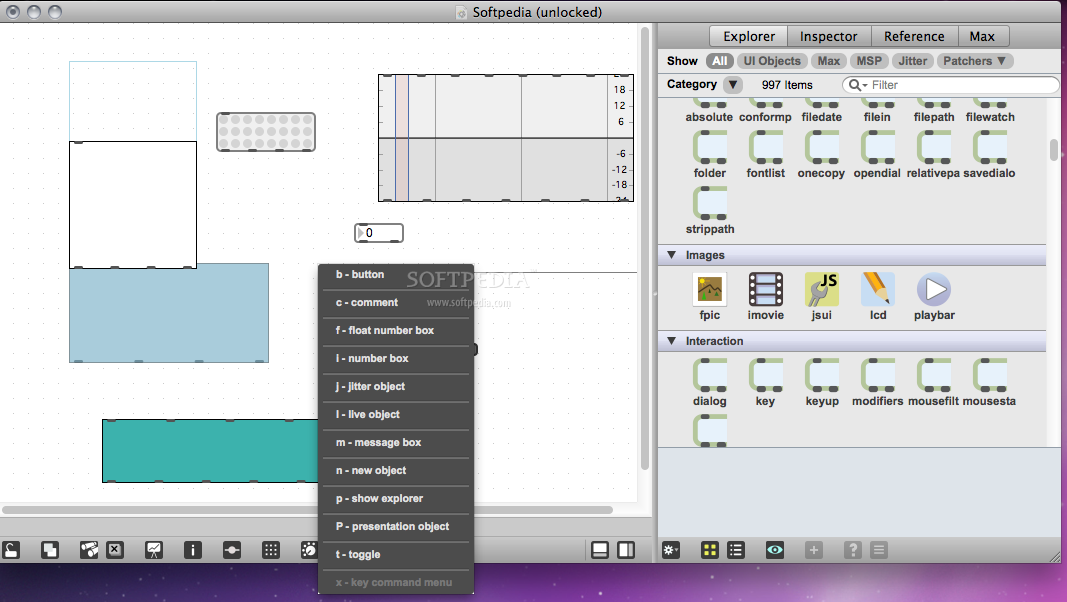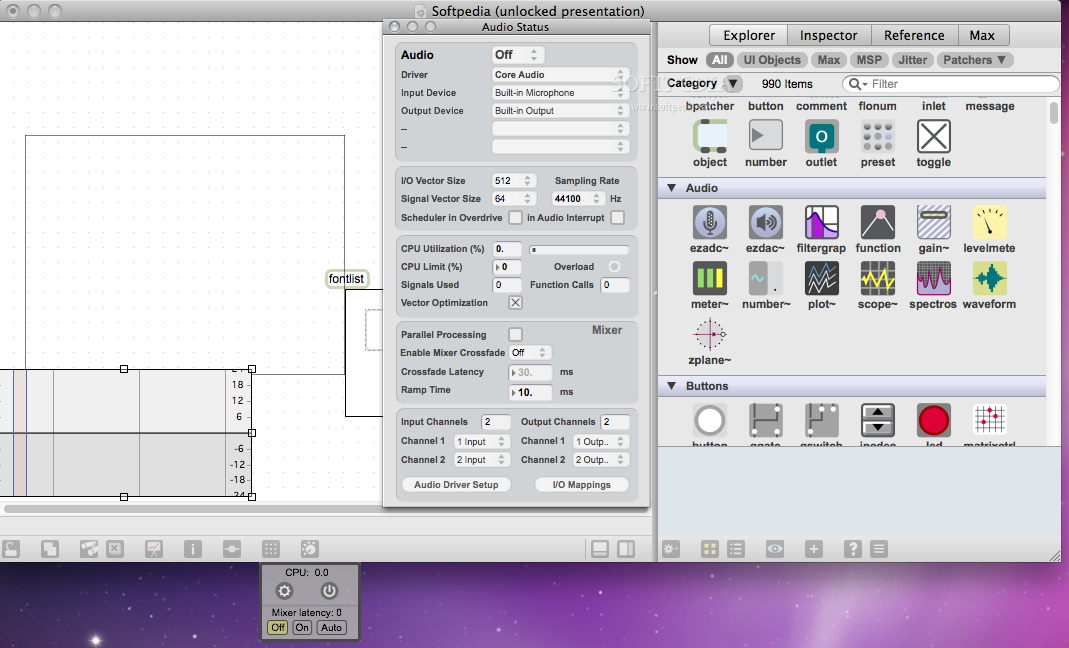This program generates quirky piano music. It was made using MAX / MSP. Useful to generate piano music to set atmospheric moods, perfect for halloween. It is also provides access to musical composition without having to have learn how to read music. Downloads: 1 This Week Last Update: 2016-07-29 See Project. This update brings initial Mac OS 10.15 Catalina support and “darkmode” window toolbars. 1 No Root latest version (iOS Android Windows) free download; Adobe. 19 downloadOffice Max Msp 6 Os X Crack Torrent - DOWNLOAD. Cycling '74 Max 7.3.3 Mac Torrent Download. Eset nod 32 anti virus 4.0.468.0 crack; adobe after effects fx cs3 for mac os x.Look at most relevant Max msp 6 mac taringa websites out of 454 Thousand at. A library of over 125,000 free and free-to-try software applications for Mac OS. Max/MSP free download Max/MSP Control for. Download latest. Trusted Mac download Max/MSP 5.1. Virus-free and 100% clean download. Get Max/MSP alternative downloads. MSP Center Plus v.1.0 MSP Center Plus is an integrated MSP Platform that helps you (Managed Service Providers) deliver IT Automation Services to your customers remotely. MSP v.5.0964 Download, analyse and graph free share prices and ASX announcements from the internet. Allows multiple watch lists, historical share prices, portfolio tracking.
Max msp free download. FTM FTM is an extention for real-time sound/multlimedia environments such as Max/MSP or PD providing com. The very first thing; how to download and install Max 7 on your computer. Skip navigation Sign in. This video is unavailable. Watch Queue Queue. About file types supported by MaxMSP. File.org aims to be the go-to resource for file type- and related software information. We spend countless hours researching various file formats and software that can open, convert, create or otherwise work with those files.
Cycling 2017 Mac A full kit of creative tools for sound, graphics, music and interactivity in a visual environment. Cycling mac crack is built on the idea of connecting things together to make something new. Connect plugins, media players, and custom DIY effects, or build something completely from scratch. Embed Javascript, Java, GLSL shaders, or compile your own C objects if you like programming too. Max provides everything from the most basic nuts and bolts to advanced effects modules that are ready to use. Mix, match, and tinker without limits.

With Max, you can:
- Make your own tools for sound, graphics, music and interactivity in a visual environment.
- Connect boxes together to make interactive sounds, graphics, custom effects, and rich experiences.
- No matter what you have on your table Arduino, controllers, synthesizers, DMX lighting, projectors, live inputs you can probably make it talk to Max.
- Quickly patch together an idea, make a working prototype, or develop a complex interactive system.
Max Msp Runtime
We thrive in the unexpected and improbable. Quickly patch together an idea, make a working prototype, or develop a complex interactive system. Patching in Max encourages exploration and invites you to change your mind. Since we began, Cycling has been dedicated to removing limits with Max. Today Max is used all over the world in museums, music studios, galleries, universities, art schools, stages, research labs, and anywhere the limits of technology and creativity are being tested. We constantly hear that learning Max is an empowering, even life-changing experience. That’s why we believe in making Max accessible to everyone. Download Max to begin a 30-day free demo. Our new interactive lessons will get you patching immediately. From there, explore tutorials on everything from sound-responsive graphics to creative vocal sampling and retuning. Everyone does something unique with Max, and we know you will too. We can’t wait to see what you make.
Requirements:
- Mac OS X Kodiak, 10.0 (Cheetah), 10.1 (Puma), 10.2 (Jaguar), 10.3 (Panther), 10.4 (Tiger), 10.5 (Leopard), 10.6 (Snow Leopard), 10.7 (Lion)
- OS X 10.8 (Mountain Lion), 10.9 (Mavericks), 10.10 (Yosemite), 10.11 (El Capitan) and
- macOS 10.12 (Sierra) and later Version.
- Supported hardware: Intel or PowerPC Mac.
mirror link
| Developer(s) | Cycling '74 |
|---|---|
| Stable release | |
| Written in | C, C++ (on JUCE platform) |
| Operating system | Microsoft Windows, macOS |
| Type | Music and multimedia development |
| License | Proprietary |
| Website | cycling74.com/products/max/ |
Max 7 | |
| Paradigm | visual, flow-based, declarative, domain-specific |
|---|---|
| Developer | Cycling '74 |
| Stable release | |
| Website | cycling74.com/products/max/ |
Max, also known as Max/MSP/Jitter, is a visual programming language for music and multimedia developed and maintained by San Francisco-based software company Cycling '74. Over its more than thirty-year history, it has been used by composers, performers, software designers, researchers, and artists to create recordings, performances, and installations.[1]
The Max program is modular, with most routines existing as shared libraries. An application programming interface (API) allows third-party development of new routines (named external objects). Thus, Max has a large user base of programmers unaffiliated with Cycling '74 who enhance the software with commercial and non-commercial extensions to the program. Because of this extensible design, which simultaneously represents both the program's structure and its graphical user interface (GUI), Max has been described as the lingua franca for developing interactive music performance software.[2]

History[edit]
1980s:Miller Puckette began work on Max in 1985, at the Institut de Recherche et Coordination Acoustique/Musique (IRCAM) in Paris.[3][4] Originally called The Patcher, this first version provided composers with a graphical interface for creating interactive computer music scores on the Macintosh. At this point in its development Max couldn't perform its own real-time sound synthesis in software, but instead sent control messages to external hardware synthesizers and samplers using MIDI or a similar protocol.[5] Its earliest widely recognized use in composition was for Pluton, a 1988 piano and computer piece by Philippe Manoury; the software synchronized a computer to a piano and controlled a Sogitec 4X for audio processing.[6]
In 1989, IRCAM developed Max/FTS ('Faster Than Sound'), a version of Max ported to the IRCAM Signal Processing Workstation (ISPW) for the NeXT. Also known as 'Audio Max', it would prove a forerunner to Max's MSP audio extensions, adding the ability to do real-time synthesis using an internal hardware digital signal processor (DSP) board.[7][8] The same year, IRCAM licensed the software to Opcode Systems.[9]
1990s:Opcode launched a commercial version named Max in 1990, developed and extended by David Zicarelli. However, by 1997, Opcode was considering cancelling it. Instead, Zicarelli acquired the publishing rights and founded a new company, Cycling '74, to continue commercial development.[10][11][12] The timing was fortunate, as Opcode was acquired by Gibson Guitar in 1998 and ended operations in 1999.[13]
IRCAM's in-house Max development was also winding down; the last version produced there was jMax, a direct descendant of Max/FTS developed in 1998 for Silicon Graphics (SGI) and later for Linux systems. It used Java for its graphical interface and C for its real-time backend, and was eventually released as open-source software.
Meanwhile, Puckette had independently released a fully redesigned open-source composition tool named Pure Data (Pd) in 1996, which, despite some underlying engineering differences from the IRCAM versions, continued in the same tradition. Cycling '74's first Max release, in 1997, was derived partly from Puckette's work on Pure Data. Called Max/MSP ('Max Signal Processing', or the initials Miller Smith Puckette), it remains the most notable of Max's many extensions and incarnations: it made Max capable of manipulating real-time digital audio signals without dedicated DSP hardware. This meant that composers could now create their own complex synthesizers and effects processors using only a general-purpose computer like the Macintosh PowerBook G3.
In 1999, the Netochka Nezvanova collective released nato.0+55, a suite of externals that added extensive real-time video control to Max.
2000s:Though nato became increasingly popular among multimedia artists, its development stopped in 2001. SoftVNS, another set of extensions for visual processing in Max, was released in 2002 by Canadian media artist David Rokeby. Cycling '74 released their own set of video extensions, Jitter, alongside Max 4 in 2003, adding real-time video, OpenGL graphics, and matrix processing capabilities. Max 4 was also the first version to run on Windows. Max 5, released in 2008, redesigned the patching GUI for the first time in Max's commercial history.
2010s:In 2011, Max 6 added a new audio engine compatible with 64-bit operating systems, integration with Ableton Live sequencer software, and an extension called Gen, which can compile optimized Max patches for higher performance.[14] Max 7 was released in 2014 and focused on 3D rendering improvements.[15] On September 25, 2018 Max 8, the most recent major version of the software, was released.[16] Some of the new features include MC, a new way to work with multiple channels, JavaScript support with Node for Max, and Vizzie 2.[17]
On June 6, 2017, Ableton announced its purchase of Cycling '74, with Max continuing to be published by Cycling '74 and David Zicarelli remaining with the company.[18] Programs sharing Max's visual programming concepts are now commonly used for real-time audio and video synthesis and processing.
Language[edit]
Max is named after composer Max Mathews, and can be considered a descendant of his MUSIC language, though its graphical nature disguises that fact. Like most MUSIC-N languages, Max distinguishes between two levels of time: that of an event scheduler, and that of the DSP (this corresponds to the distinction between k-rate and a-rate processes in Csound, and control rate vs. audio rate in SuperCollider).
The basic language of Max and its sibling programs is that of a. Hopes&Fears. Retrieved 2018-09-16.
journal= (help)[permanent dead link][dead link] journal= (help) journal= (help)